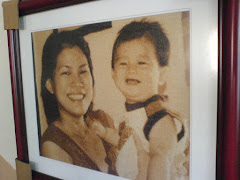When you cross stitch, have you noticed that occasionally your thread (floss) gets tangled, split, frayed or weak? This can be very noticeable when you use metallic or other rough threads.
If this is a problem, it's time to try a floss (thread) conditioner. Originally, some ingenious stitchers coated their threads with beeswax to soften threads. However, using this can sometimes result in lumpiness or a sticky feel to the project.
'Thread Heaven' is one such conditioner that can be the answer to your stitching prayers. It provides a coating that allows your thread soft and pliable, allowing it to glide through the fabric easily, making stitching easier.
To use 'Thread Heaven':
You first separate the strands of thread, coating them individually by drawing the strands across the surface of the conditioner.
Then you will need to draw the thread between your forefinger and thumb. This will create a minute static charge that reduces tangling.
After many uses, 'Thread Heaven' will become soiled from tiny filaments from your thread. Simply turn the product out of its box with the tip of your scissors. Hey presto - a clean side will be exposed for further use. Most stitchers claim that they didn't know how they managed before they bought it.
Some people recommend having two boxes of 'Thread Heaven' - one for light colours, and another for dark. This extends the life of the product.
An additional way to deal with thread that splits or tangles is to use shorter lengths for stitching. The thread therefore creates less friction with the fabric as you stitch.
Tumble dryer sheets...
Some clever stitchers keep tumble dyer sheets in their workboxes.
This is because these sheets prevent static build-up in clothes when you dry them in the tumble dryer. So - not surprisingly, they work like magic on your threads too. Just draw a length of thread between a folded tumble dryer sheet, and you will notice the difference.
source: patternspatch.com
Sunday, October 26, 2008
Friday, October 10, 2008
Adding a Simple Border to a Cross Stitch Design
Use ordinary cross stitches all around your fabric as close to the edge as possible before you start the project. Be sure to allow room for your work.
For a small design just do one line all the way round. For larger designs add more lines of cross stitches. When adding more lines, use more than just one color, picking up colors from the Cross Stitch design you are stitching. Try to pick colors that will not take your eyes away from the finished piece of work.
Adding these borders has the added benefit of stopping the material on the edge of your work from fraying too much.
source: crossstitch.about.com
For a small design just do one line all the way round. For larger designs add more lines of cross stitches. When adding more lines, use more than just one color, picking up colors from the Cross Stitch design you are stitching. Try to pick colors that will not take your eyes away from the finished piece of work.
Adding these borders has the added benefit of stopping the material on the edge of your work from fraying too much.
source: crossstitch.about.com
What would I do if....
I have finished stitching one area, and there is another one nearby that I want to stitch in the same color. There is still some thread left in my needle.
Do not carry thread far on the back if you are going from one area of the design to another. Even the slightest pull will cause a pucker. To get from one area to another that is nearby, you can run your thread under stitches on the back for short distances, as long as the two yarn colors involved are similar. Otherwise, end off your thread and restart it at the new area. Never carry a very dark color when you are working on a light color fabric.
source: caron-net.com
Do not carry thread far on the back if you are going from one area of the design to another. Even the slightest pull will cause a pucker. To get from one area to another that is nearby, you can run your thread under stitches on the back for short distances, as long as the two yarn colors involved are similar. Otherwise, end off your thread and restart it at the new area. Never carry a very dark color when you are working on a light color fabric.
source: caron-net.com
Beware of Darker Colored Yarns
The darker dye processes are tough on fibers. Many darker colored yarns are thinner and have a different character from the lighter yarns. You may find, for example, that two strands of a certain light colored yarn will cover the canvas adequately, but when you go to a dark color, three strands are needed. The dark colors may be much weaker as well.
source: needlepointfun.com
source: needlepointfun.com
Wednesday, October 8, 2008
What should you do ... If made a mistake in your stitching...
If you make a mistake that involves only your last few stitches, remove your needle from the thread and, using the end with the eye, slide the needle under the last stitch and pull up, taking out the thread. Continue to take the stitches out one at a time until the error has been removed. If the mistake is over a large area, you must carefully slide sharp embroidery scissors under the stitches and snip, being careful not to cut the fabric.
source: caron-net.com
source: caron-net.com
Subscribe to:
Comments (Atom)






